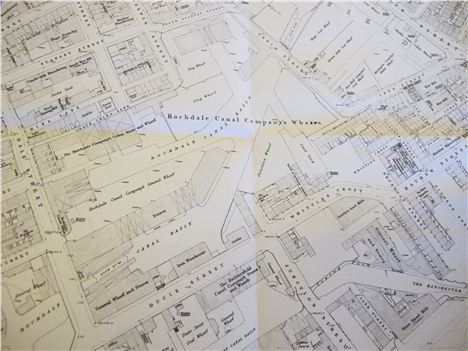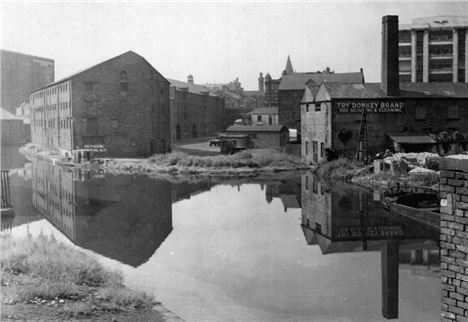THIS is Piccadilly Basin. The pictures are taken from the recent curving footbridge over the Rochdale Canal.
In the centre of the panorama, above the litter picking canal boat, is architectural practice BDP’s splendid and self-designed, Manchester offices from the noughties.
On the panoramic view below, this joins with the Ashton Canal on the left. Both canals were completed around the time the eighteenth century turned into the nineteenth century. The Rochdale Canal was the first canal to link west with east coasts, via the Bridgewater Canal in the west to the Mersey Estuary and the navigable river systems in Yorkshire to the east.
 Panorama south to north Piccadilly Basin
Panorama south to north Piccadilly Basin
As the 1849 map below shows, the canal basins were formerly much more extensive. Where the car park now lies were canal arms leading to the Rochdale Canal Company's main office and their Dale Street Warehouse. This is the stone building right of centre and dates from 1806 built in Pennine Millstone Grit, unusual in Manchester and clearly brought down from the moors on the Rochdale Canal.
1849 Ordnance Survey map
This building now hosts Marketing Manchester and Visit Manchester, the city’s tourism authorities. It has four shipping arches at ground level which once opened into the water of the canal so goods could be loaded and vice versa. Hidden inside is a surviving water wheel previously used to power pulleys for lifting goods between the levels.
Two other buildings are noteworthy.
In the centre of the panorama, above the litter picking canal boat, is architectural practice BDP’s splendid and self-designed, Manchester offices from the noughties. This engages beautifully with the canal whilst also echoing the splendid white tiled former textile warehouse to the right of the 1806 building housing Marketing Manchester. The grid of this warehouse is an early example of Modernist Movement architecture in the city.
The old picture here dates from the 1950s and shows how the canal arm leading to the stone warehouse had been filled in during the 1920s as canal traffic disappeared. It also shows the spectacular cap to our Modernist warehouse - now gone.
1950s' view
The low building in the middle foreground advertises the famous Donkey Brand. This company produced donkey stones in a mill in Ashton-under-Lyne down the canal. Donkey stones were an aggregate of pulverised stones, bleach powder, cement and water and were used by every proud housewife on every terraced street to add lustre to their doorsteps.
The other panoramic view below takes in the view south, north and east and includes in the distance down the canal the important Brownsfield Mill from 1825.
In 1909 webbing manufacturer Humphrey Roe went into partnership with his younger brother, Alliot. He allowed the latter to use part of the building as Britain’s first aeroplane factory, making planes in kit form before being assembled for flight.
A V Roe’s efforts would eventually prove successful and result in the AVRO aeroplane company which in turn would produce machines such as the Lancaster and Vulcan bombers. Humphrey meanwhile, the far more engaging of the siblings, would marry Marie Stopes and encourage and support her in setting up Britain’s first birth control clinic.
The latter seems a progressive initiative, worthy and all that, so it's a shame that Stopes was a thoroughly unattractive character, an anti-semitic eugenicist who mocked and humiliated her affable husband and wrote letters of support to Adolf Hitler.
Panorama south to east including Brownsfield Mill over the canal in the right distance
You can follow Jonathan Schofield on Twitter here @JonathSchofield or connect via Google+


















